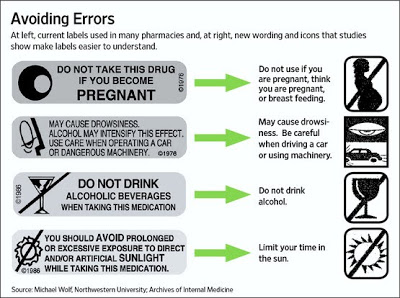Every Rx drug is supposed to include an FDA-approved “package insert” (PI) that provides information about the drug, including instructions for taking the drug and warnings about interactions and side effects. Most official PI’s, however, are pretty technical and difficult to read, especially by seniors who may have problems reading the small type.
Besides being difficult to read, the official PI often is NOT included with your prescription — the pharmacy asks you to sign a sheet, however, that indicates you have been informed about the drug. Thus, they don’t need to give you the PI unless you specifically ask for it.
In an effort to make PI’s easier to read and understand — and perhaps to save money on printing costs — the FDA is “planning to test single-page consumer information sheets that would replace the multi-page package inserts and medication guides widely used in retail pharmacies,” according to this story in the Wall Street Journal. According to the WSJ:
Michael Wolf, an associate professor at Northwestern University’s Feinberg School of Medicine who serves on an FDA risk-communication advisory panel, says in recent studies, more than half of adults misunderstood one or more common prescription warnings and precautions. In one study Dr. Wolf and colleagues found that patients better understood simple, explicit language on warning labels—like “use only on your skin” instead of “for external use only”—and those with lower literacy skills also benefited from picture icons, such as a sun with a black bar across with words, “limit your time in the sun.”
Proposed labeling changes would look like this:
Not only are these changes simpler and easier to read, the icons are more grounded in the culture of the “common man.” The current icon for DO NOT DRINK uses a martini glass including an olive (or is it a more upscale onion?). The new proposed icon uses what appears to be a wine glass. Perhaps an even better choice would have been a can of beer?
However “dumbed down” the label gets, it is still important that physicians and pharmacists take a more pro-active role in educating consumers about the drugs they are taking.
“Doctors and pharmacists are also being encouraged to counsel patients more effectively about their medications,” reports the WSJ. “About 100 industry and nonprofit groups are participating in a national awareness campaign about the importance of taking medication as directed, to be launched in May by the National Consumers League. The campaign includes a website for health professionals and a separate website where consumers can download tools such as work sheets to manage their medications. The group says more than a third of medication-related hospital admissions are linked to poor medication adherence.”
Patient Behavioral Coaching Podcast
Pharmacists have been recognized as a vital part of the patient support team and play an important role in offering patient care and health behavior change services that help increase patient access to healthcare and improve the quality of care.
This Thursday (April 28, 2011; 2 PM Eastern US) I will have a live online conversation with Stacey Irving, Senior Director, Channel Marketing, and Derek Rago, VP Marketing & Strategy, at McKesson Patient Relationship Solutions, about the McKesson Pharmacy Intervention Program, which expands patient access to one-on-one behavioral coaching about the importance of taking medicines from retail pharmacists in the McKesson network.
You can listen to the live interview here or to the audio podcast afterward here.
I will also be the guest moderator for the #socpharm Wednesday night Twitter chat, the focus of which will be patient adherence (8 PM Eastern US). Find more information about #socpharm here.









![6 Digital Tools at the Center of Healthcare Digitalization [INFOGRAPHIC]](http://ec2-54-175-84-28.compute-1.amazonaws.com/pharma-mkting.com/wp-content/uploads/2021/04/6DigitalTools_600px-100x70.jpg)




